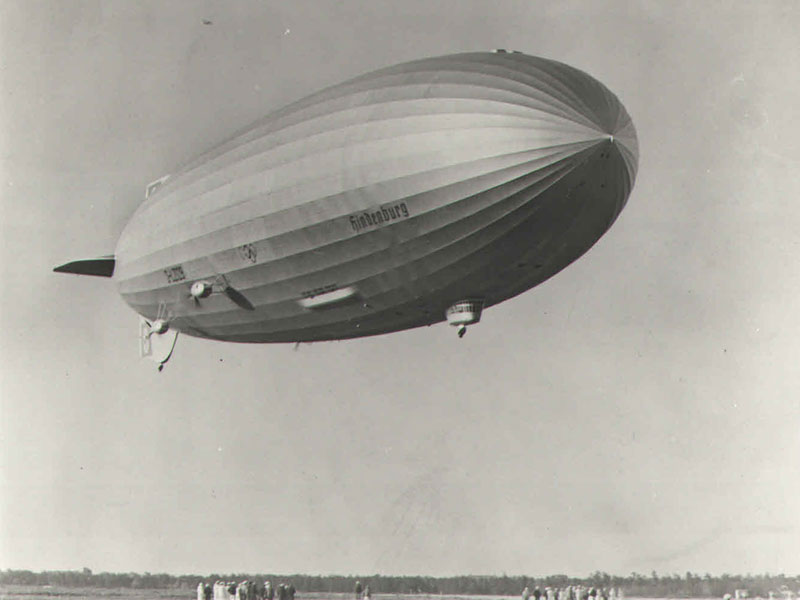The Zeppelin Hindenburg: When Airships Ruled | The Most Amazing Flying Machines Ever

This is part of a SPACE.com series of articles on the Most Amazing Flying Machines Ever, the balloons, airplanes, rockets and more that got humans off the ground and into space.
Huge airships once embodied the future of air travel as they carried passengers across the world's oceans. That dream exploded when the zeppelin Hindenburg, the largest aircraft to ever fly, burst into flames during an attempted landing in New Jersey and collapsed into a smoldering ruin within just half a minute.
The cigar-shaped Hindenburg stretched the length of three football fields at almost 804 feet — more than three times longer than a Boeing 747 jumbo jet. That made it perhaps the most impressive of the rigid airships that used propellers for steering and filled up buoyant cells with hydrogen or helium gas to float through the sky. Such rigid airships stand in contrast to the inflatable designs of hot air balloons and blimps.
Zeppelins made by the German company Luftschiffbau Zeppelin carried out the first strategic bombing missions during World War I. The United States also experimented with turning rigid airships such as the USS Macon and USS Akron into flying aircraft carriers during the 1930s.
Flying across oceans
After World War I, airships began providing the first commercial transatlantic flights during the 1920s and 1930s. Passengers flocked to the zeppelin service as a quicker and cheaper way to cross the world's oceans compared to buying passage on ships. Even New York's Empire State Building had plans to allow dirigibles to dock with its spire (a plan scuttled by gusty winds).
A sister ship of the Hindenburg, the Graf Zeppelin, set the record for flying more miles than any airship. Its 590 flights covered more than one million miles (1,609,344 kilometers) included 144 ocean crossings during 10 years of service. It also flew around the world in just 12 days in 1929.
The Hindenburg made just 63 flights after its construction in 1936. But it could carry more than 70 passengers in style with its own dining room, a writing room, a lounge with a grand piano, and plenty of windows on the sides for viewing the scenery below.
Passengers even enjoyed having their own post office aboard the Hindenburg — the airship represented the largest flying post office ever, according to the U.S. National Postal Museum. The Hindenburg also provided the first regularly scheduled air post service between Europe and North America.
A fiery end
The Hindenburg's end came when it prepared to land at Lakehurst, New Jersey, on May 6, 1937. Flames erupted as the airship settled in near its mooring mast, and the huge airship was consumed within just 32 seconds. Luckily, 62 of the passengers and crew survived by jumping out the windows to the ground — the death toll came to 35 people on board and one member of the ground crew.
Historians still debate what brought about the downfall of the Hindenburg and the end to people's confidence in hydrogen-filled airships. Many have pointed to the flammable hydrogen gas as the reason why the airship went up in flames so quickly. A competing theory that implicated incendiary paint on the outside of the airship was largely discredited by a 2005 paper.
Whatever the case, the golden age of airships was over. Fixed-wing aircraft continued their rise as they dominated the skies for both war and commercial flights.
But lighter-than-air blimps or hybrid airships could still end up flying into the future. The U.S. military has experimented with using both blimps and airships as high-flying surveillance platforms over battlefields, and planetary scientists envision robot blimps soaring on Mars or other worlds someday.
Related:
The Greatest Moments in Flight
- The First Hot-Air Balloon
- The First Powered Airship
- The Wright Brothers & the First Flight
- World's First Commercial Airline
- Charles Lindbergh & the First Solo Transatlantic Flight
- Breaking the Sound Barrier
The Most Amazing Flying Machines Ever
- The First Airplane: Wright Flyer
- The Red Baron & Aerial Weapons of World War I
- The First Fighter Jet: Me 262 Schwalbe
- SR-71 Blackbird: Supersonic Spy Aircraft
- Saturn V Rocket & Apollo Spacecraft
Image galleries:
Join our Space Forums to keep talking space on the latest missions, night sky and more! And if you have a news tip, correction or comment, let us know at: community@space.com.
Get the Space.com Newsletter
Breaking space news, the latest updates on rocket launches, skywatching events and more!
Jeremy Hsu is science writer based in New York City whose work has appeared in Scientific American, Discovery Magazine, Backchannel, Wired.com and IEEE Spectrum, among others. He joined the Space.com and Live Science teams in 2010 as a Senior Writer and is currently the Editor-in-Chief of Indicate Media. Jeremy studied history and sociology of science at the University of Pennsylvania, and earned a master's degree in journalism from the NYU Science, Health and Environmental Reporting Program. You can find Jeremy's latest project on Twitter.










